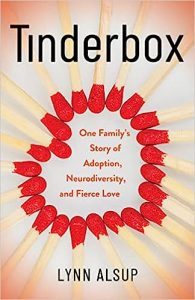On Writing Tinderbox: One Family’s Story of Adoption, Neurodiversity, and Fierce Love
 You know those writers in the movies with a whiskey glass always at hand? A cigarette’s red tip glows at their lips as they click the keyboard keys. They lounge at parties with other artists until the sun comes up. I’ve dreamt of that life. (Although, they always seem to be men, yes?!) In my actual writing process, tea steams in the cup next to my laptop at 9:00 am after I put away last night’s clean dishes and feed the dogs. Reality, alas.
You know those writers in the movies with a whiskey glass always at hand? A cigarette’s red tip glows at their lips as they click the keyboard keys. They lounge at parties with other artists until the sun comes up. I’ve dreamt of that life. (Although, they always seem to be men, yes?!) In my actual writing process, tea steams in the cup next to my laptop at 9:00 am after I put away last night’s clean dishes and feed the dogs. Reality, alas.
We imagine writers living in their heads, but my stories hinge on at least a modicum of health in my body: mostly tea for whiskey or wine. The ideal day’s work begins the night before with not too much sugar or wine and a full night’s sleep if I’m lucky. Especially if writing gets woven in with other work and I need an extra sharp mind for each moment I can carve out. It turns out writing is physical. Shoulders sore? Hip hurts? Brain fuzzy ? Break for yoga or a walk with Bryn the Bassador, my dog rescuer. Migrating from the back porch where I spend most mornings to my studio, I sit on the floor. My laptop perches on a wicker box until it’s time to move again. Next stop: an old pine table that serves as my desk.
When I write new scenes for a project, I rummage around for a used notebook or the end of a legal pad that my kids have discarded and grab a pen. Writing longhand without stopping—no crossing out or changing words—for 30 minutes or more uncovers what I have to say. Blank notebook pages help me get unstuck, too. A writing exercise using the pesky scene develops a sense of place, pace and flow, or dimension. The words scrawled across the lines become the flesh on the bones of my ever-changing outline. Alternating between picking up a pen to free-write, typing in scenes from my notebooks, and editing earlier chapters shifts my body and keeps my brain fresh and working.
If I lose that clarity, the project offers endless alternatives. I research details that bring sentences to life. What exact shade of orange was that favorite tunic my daughter wore at three-years-old? What do winter trees in Missouri look like exactly? Thank you, Google! Creating a new website while I wrote Tinderbox: One Family’s Story of Adoption, Neurodiversity, and Fierce Love meant I pivoted to that when words escaped me. I also devour great writing in the genre in which I’m working. So many memoirs alongside Tinderbox. Reading them keeps my mind flexible and full of great words and structures that come through my subconscious into my fingers and land in my notebooks. All these things maintain my momentum when words don’t flow on the page or screen.
Collaborating with other writers keeps my process on track, as well. Write to the Finish (WttF) with Tania Casselle and Sean Murphy provided structure, feedback, accountability, and honed my craft for Tinderbox. One of my writing partners from WttF turned me on to A Very Important Meeting (AVIM). I jump online with that community to meditate and write with fascinating people around the world. In both groups, we log on, connect with a quick check in (and short meditation on AVIM), click mute, and write. Sometimes for 45 minutes; sometimes hours. An appointment with like-minded souls gets my butt in the chair and extricates me from watering plants and searching for new, eco-friendly sunglasses online (both of which I’ve done before sitting down to write this!). Companions share tips, encouragement, and free me from the echo chamber in my mind.
Once I’m in the chair, two or three hours let me sink in and settle in the still place at my center from where the good stuff comes. Meditating before writing helps with this, too. For a book-length project, I also need immersion, binge writing. My brain doesn’t multitask, so a retreat to focus on the book is a great gift. I become a nomadic writer. I load up my orange Subaru with notebooks, piles of research, and food and head to far west Texas where wide-open spaces and desert beauty conjure their magic. For two or three days I balance sleep, meditation, long walks, simple, good food and hours and hours of writing. Add in a bit of dark chocolate, copious cups of coffee and tea, and a glass of wine at the end of the day—Vino Verde for summer and Cabernet for all the days—and a book comes to life.
In the end, mounds of those scenes born in the desert lie on the floor rather than the pages. “Delete” is a vital part of my writing process. Sifting words reveals the ones integral to the story. Typically, I lean toward efficiency, not expending more energy than necessary. But telling my stories demands meandering, wandering, getting lost and found, letting go. Some folks crank out books in six months but not me (or many writers I know). Tinderbox unfolded over four years from first word to final copy. One of my writing partners says, “It just takes a long time to write a book.” Amen to that.
I suppose for me it comes down to balance. Of mind and body, discipline and flexibility, pens and keyboards, solitude and community, digging up words and tossing them in the compost. Even without loads of whiskey, cigarettes, and parties, the writing process brings me to life.
https://www.facebook.com/lynn.alsup.96
https://www.instagram.com/lynnalsup
Tinderbox: One Family’s Story of Adoption, Neurodiversity, and Fierce Love
 Lynn watched her beloved Clare, newly adopted from Haiti, crawl the house in a frantic search for her lost mother.
Lynn watched her beloved Clare, newly adopted from Haiti, crawl the house in a frantic search for her lost mother.
Preschool Clare enchanted with belly laughs and shining smiles. Also, thrashed and wailed in her room as Lynn crouched on her own bed—pillow clutched over her head—her past trauma triggered. A pre-teen trip to Haiti brought sunshine, ruby red hibiscus blooms, and the music of Haitian Creole. Back at home, Clare shattered mirrors into shards on the subway tiles of their bathroom. And just before her thirteenth birthday, as she and Lynn walked hand in hand through their neighborhood, Clare calmly detailed her plan to die.
Over the next years, Lynn and her family walked through psychiatric hospitals, along the Appalachian Trail, and in and out of residential placements, marriage, faith, and sanity barely surviving the journey. But then Lynn learned about fetal alcohol spectrum disorder (FASD)—a source of neurodivergence in one in twenty American children—and discovered the FASCETS Neurobehavioral Model, a strengths-based approach to celebrating and accommodating neurodiversity. It was a discovery that transformed them all.
At times joyous, at times harrowing, but always full of love, Tinderbox is a mother’s story of brokenness, unrelenting resilience, and hope.
BUY HERE
Category: How To and Tips























